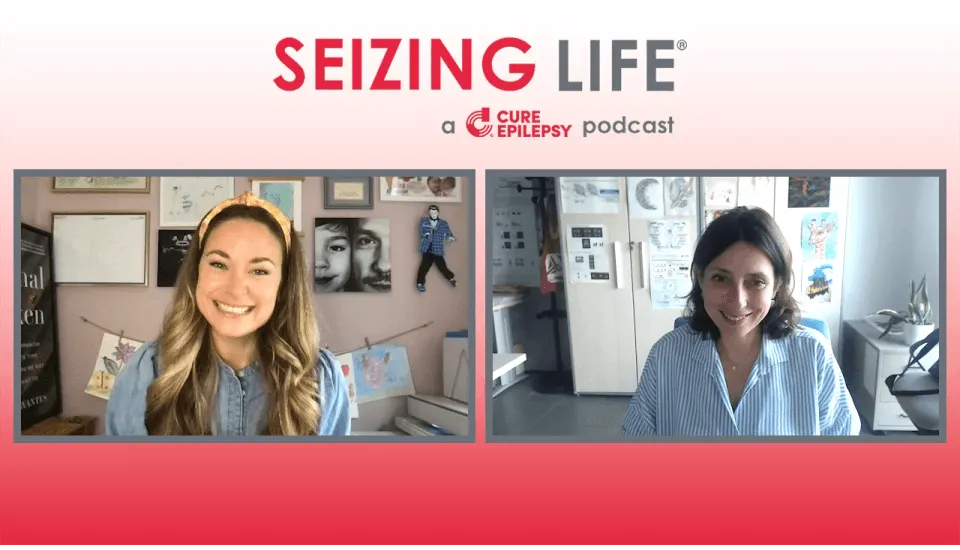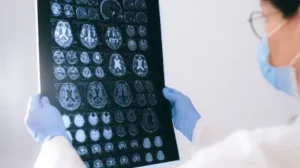Episode Overview
The teenage years can be challenging for both parent and child. The life of a teenager is a continual balance of school and social activities, and can be full of emotional swings brought on by physiological changes that take place during adolescence. But when epilepsy is added to the mix, the challenges can increase exponentially. What can you do as a parent to help your child navigate this difficult period of life while also dealing with a difficult health condition.
Episode Transcript
Certainly, I’ll remove the timestamps and add spaces between speakers. Here’s the reformatted version:
Kelly Cervantes: Hi, I’m Kelly Cervantes and this is Seizing Life, a biweekly podcast produced by CURE Epilepsy. Today, I’m happy to welcome Angie Froehlich to the podcast. Angie’s daughter, Chloe, was diagnosed with juvenile myoclonic epilepsy when she was 12 years old. Angie is here today to discuss Chloe’s epilepsy journey from a parent’s perspective and to shed light on the physical, social and psychological impacts that epilepsy can have on a teenager, as well as the subsequent challenges it brings to parenting.
Kelly Cervantes: Angie, thank you so much for joining us today. I’ve been so looking forward to this conversation. We’re going to jump right in. I would love to learn how epilepsy first entered your life. We’re here today to talk about your daughter, Chloe. So how did it present in her, and what was your journey to a diagnosis?
Angie Froehlich: Well, our journey started, or her journey started, four and a half years ago. Before that, perfectly healthy child, very active, very busy, motivated, on top of things, never a dull moment, and that quickly changed. We were actually in Minneapolis for a soccer tournament for her. It was just her and I down there. We had gotten down to… or down to Minneapolis late on Friday night, and they played early. She’s one of those that never liked to, historically, eat much or drink much while she was playing. She thought it took away from her game. And so, they played three games that morning. She did collide with somebody else, but they didn’t hit heads or anything, and she was fine, she bounced right back up. And so, we had went to eat, went back to the hotel and showered and everything.
Angie Froehlich: And while we were at Mall of America, shortly after we ate, we were looking at an art display, and out of the corner of my eye, I see her go down. And at first, I thought she had tripped on this easel that was right there, quickly realizing that was not the case. I knew enough about medical. I’ve worked in healthcare for 20 years. I also had taken some EMT classes, so I knew enough to recognize that it appeared to be a seizure of some type. Fortunately, we had a couple people in the mall. One was a paramedic and one was a nurse that just happened to be there, at the right place, at the right time. And they quickly came to help us. They called 911, and they were so good with me, as far as explaining the postictal period.
Angie Froehlich: And fortunately, she came out of it within five minutes, but she definitely had a grand mal seizure. And in that moment, your whole world freezes because you don’t know what’s going on. And so, the whole ride to the ambulance, she was starting to come around, and her biggest worry was letting the team down and playing her game the next day. And we quickly reassured her that the team would understand and that we just need to figure out what’s going on with her. And so, we went to Hennepin County Medical Center, which is the largest hospital level one trauma center in Minneapolis. And I have to say, our experience there was nothing but positive. About three and a half hours, we were in and out. They had done every test under the book, gotten the results back. They ruled out anything critical, life-threatening, and they told us to follow up with her primary care physician on Monday when we were back in Fargo.
Kelly Cervantes: Now, was there any mention of epilepsy from those doctors at that point, or they’re ruling out brain tumors, they’re ruling out the big, awful, scary stuff, and they send you on your way back to her pediatrician?
Angie Froehlich: Exactly, yeah, no mention of epilepsy. Never once crossed my mind, honestly, because once we were back in Fargo, I was talking to my sister-in-law, and she had had a similar experience when she was about 12, also, and it was related to blood sugar. And so, I kind of talked myself off the edge of the cliff, and really thought and prayed that it was a one-time occurrence. And so, that Monday, we went to see her pediatrician. They were able to get her in right away. He ordered an EEG, he checked over everything else, neurologically, that he could in the office there, and really didn’t see anything that stood out, but wanted to do the EEG. And so, we did that Wednesday of that week, so relatively quickly, at least. So we go on Wednesday, we do that. And while I’m sitting there, they did the strobes and it looked like she was having issues with that.
Angie Froehlich: And then I think we were there about maybe two o’clock that afternoon, two or three o’clock. And by 5:30, I had a call from the pediatrician and he sounded all upbeat. He said, “Yep, we got what we needed to see.” And I’m thinking, “That sounds positive,” and then he says, “Your daughter has juvenile myoclonic epilepsy,” and you feel like the world stops. I was like, “What?” And so, he just calmly said, “We just need to start her on medication. She’s going to start that today, and, of all the epilepsies, it’s probably the best one to have, and she’ll go on to have a normal, healthy life.” And her meds, she started Keppra that day, she was so exhausted that she just slept, literally about 18 to 20 hours a day. And fortunately, it was in the summer, so I don’t know what she would have done. The girl would sleep constantly, but she wanted to be woke up to go to soccer practice. And she was not at full capacity, by any means, but she just wanted to feel somewhat normal.
Kelly Cervantes: Well, and I’m sure she was scared too, right? I mean, if you’re not fully understanding what’s going on and the scope, there’s no way that a 12 year old is going to be able to wrap their head around that. I have to say that I’m actually fairly impressed with your diagnostic journey and how quickly it went. I mean, for so many patients, it can take months or years. Looking back now, do you think, prior to that tonic-clonic seizure, that there were any signs of epilepsy or seizures before the one in the mall?
Angie Froehlich: We do. It’s funny you should ask that, because at that time… So the thing with juvenile myoclonic, they get three different types of seizures. They get the tonic-clonics, and then they get the absence seizures, which… and are just staring. And ironically, my stepdaughter had absence seizures when she was about six years old and she outgrew them, so I was familiar with those from her experience.
Angie Froehlich: And one time during that previous year, prior to her tonic-clonic, Chloe says, “[inaudible], sometimes I feel like I’m staring like Kennedy did.” And it was always right after she had gotten very little sleep, had been at a sleepover, or… And the doctor was asking her too, “Have you had jerks in your hands or your feet, felt like you’ve dropped things easier?” And she’s like, “Well, yeah,” but she never told me about those times. There was a few times where it seemed like she was clumsier, maybe, than normal, dropped things easier. But again, you don’t put two and two together till much further down the road, and then you’re sitting there going, “Okay, there’s all these pieces of the puzzle, and now it makes sense.”
Brandon: Hi, this is Brandon from CURE Epilepsy. An estimated 3.4 million Americans and 65 million people worldwide, currently live with epilepsy. For more than 20 years, CURE Epilepsy has funded cutting-edge, patient-focused research. Learn what you can do to support epilepsy research by going to www.cureepilepsy.org. Now, back to Seizing Life.
Kelly Cervantes: She’s starting on Keppra, she’s sleeping 18 to 20 hours a day. Clearly, this is not a sustainable or livable side effect of the meds. It’s such a common, I think, in the epilepsy world, that we just sort of understand that sometimes the side effects from the medications are worse than the seizures themselves and finding that balance. What were your next steps? How did you find a balance? Have you found a balance?
Angie Froehlich: Well, so then, when we met with the epileptologist, he suggested she go on lamotrigine in the longterm, but because of the way that has to be introduced, very, extremely slowly, otherwise it can produce some lethal, deadly consequences. And so, his plan was, since we were in summertime, to slowly wean off the Keppra once we had the lamotrigine at therapeutic levels. And so, he figured that would be really the whole course of the summer before we were at therapeutic levels. And so, I think it was right, maybe the week before school started, when we had made that full transition, she was at what seemed to be a therapeutic level of the lamotrigine.
Kelly Cervantes: Was the medication working? Were you seeing fewer absence seizures? Was she feeling less of the jerks?
Angie Froehlich: She did seem to have less absence. She hadn’t had any more tonic-clonics. The myoclonics, we felt, were decreasing. They still weren’t where they wanted them to be, but it was a start. So we walked out of there, feeling good, like, okay, we might have to adjust the meds, but this is something we can handle. Well, over the course of time, that epileptologist ended up leaving that healthcare facility. She would get increased number of absence, increased myoclonic still, no more tonic-clonics. And to this day, she’s never had another tonic-clinic, but the other two types have been problematic. And there was no other neurologist or epileptologist in the state.
Kelly Cervantes: In the state?
Angie Froehlich: In the state at that time. So I could travel down to South Dakota, which would be about three and a half hours, or I could go three and a half hours to Minneapolis, to Minnesota Epilepsy Group. And from everything I had heard was, that place was phenomenal. That’s their cup of tea. That’s what they focus on, and-
Kelly Cervantes: Which is amazing, but it’s three and a half hours away, which is… I mean, that’s a trip.
Angie Froehlich: It is a trip, and I felt, because she wasn’t totally stable, I wanted the epileptologist. I wanted that specialty. I wanted the care that we’re getting down there, where it was comprehensive. I felt more heard, she felt more heard. The things we talked about, they’ve been there with so many patients. That was what they knew, and so we just stayed down there and made it work, and that’s what we’ve done since then.
Kelly Cervantes: So how often are you able to see her epileptologist, given that the care is three and a half hours away?
Angie Froehlich: Well, fortunately, she was “stable enough” that she was only needing to be seen a couple times a year. They did do an inpatient monitoring stay. We’ve done those twice. The first time, she just really… The doctor wanted a baseline. That actually made me feel a little bit better. Chloe, I don’t know that she liked it. It was difficult, frustrating, and she felt confined. She was worried about school, and missing school, and if her friends found out, because she doesn’t like to talk about it.
Kelly Cervantes: So I want to dive into that a little bit. How has that been for her? Because, I mean, I don’t know anyone who wants to go back and live those middle school, early high school years, adding on top of that, epilepsy and the anxiety of wondering when or if the next seizure is going to occur and how that must have affected her self-esteem. And how did she respond to that, and how did you parent her through that?
Angie Froehlich: Well, I will say that’s an ongoing. We still work through that. But you’re right, it’s been challenging in all the middle school years. It’s just ugly. People can be mean. These are kids that she’s known, but she was definitely… And even some of them were down, playing the soccer tournament the weekend it happened, but she still did not want to talk about it and she didn’t want anybody to know. And so, I’ve really tried to encourage her to learn to be open. She still struggles. I will use school as an example. It became very difficult for her. She used to have a sharp-as-a-whip memory. She could remember anything, and it takes her longer to retain information. She has a hard time translating the information from her brain down to paper, or verbally. Many times, she knows it once she gets it, but it takes her longer to get to that point.
Angie Froehlich: And so, just trying to teach her ways as we’ve been working through 504s and IEPs, and as she gets older, trying to teach her to advocate for herself, and emphasizing that, “Okay, these are just ideas. Some may work and some may not. This is the time to try and figure out what works for you, and just because you maybe learn differently than somebody else, doesn’t mean it’s wrong.” I try my best to fill her with positive thoughts and helping her understand she can still achieve anything she wants to in life. But she’s developed pretty severe anxiety and depression out of all this, and whether that’s from the meds or the epilepsy itself, we don’t know. When we go to Minnesota Epilepsy Group, they also have the psychologists and psychiatrists on staff, and so we generally meet with them too, down there. And that’s been pretty helpful, just because they’re used to working with, again, patients specifically that have epilepsy, and so seeing the issues that arise out of that.
Kelly Cervantes: I want to dive a little deeper into the mental health aspect because I think that that is just so incredibly important. We know that depression and anxiety are very common comorbidities with epilepsy. Are there signs to look out for that you would want to share with other parents, things that you can see in Chloe when you know she’s having a particularly challenging time?
Angie Froehlich: Yeah. I think the biggest thing is, from a school aspect, really know your child. If something looks atypical, their grades suddenly drop, they’re missing a lot of assignments… For her, that’s a trigger, because what I found with her is, she completely shuts down. Many times, she’ll have some anxiety going on and she tries so hard to keep that to herself and learn to work through it. But I’ll start noticing, okay, these assignments are missing. What’s going on?
Angie Froehlich: But I’d say, trust your gut, as far as knowing your child, and also encourage the counseling aspect. There was a period of time where Chloe was coming home in tears every day, kids were being mean, she was struggling in school, she was overwhelmed, complete shutdown mode. And I really had to get through to her. I had brought up counseling, and immediately, she shut that down. She didn’t want any part of that. And I just explained it like any other disease, like, “You’d go to the doctor to get help for a broken leg, or something going on with your skin, and it’s really no different.” I said, “You’d be surprised at the number of people that get help, and there’s nothing wrong with that. That’s great. That’s what they’re there for.”
Angie Froehlich: And at first, her first response was, “Well, I can just talk to you. I talk to you about everything,” and I said, “I know, and I’ll always be here, but these are professionals. This is what they’re trained to do, and sometimes it’s good to talk to somebody else that’s not involved in the situation because they may see things differently.” And so, she slowly opened up. She said, “Okay, fine.” And it took a while. The counselor really had to build that relationship with her. But I would also say to the counseling thing, if one doesn’t work, try somebody different, because there are so many personalities that you have to really find the right fit for you.
Kelly Cervantes: That is incredible advice all the way around, and I could not agree with you more. You talked about some of the educational effects of epilepsy, that she was requiring more time to comprehend. What were some of the specific accommodations that you requested for on those IEPs?
Angie Froehlich: Well, we have a variety. We went through the neuropsych testing process for confirmation on what we were already thinking was going on, but it really showed that her executive functioning areas is where her seizure activity was affecting her. And so, comprehending, decision-making, impulsiveness, some of those things really stood out, as well as her memory. Her working memory is good once it’s in there, or relatively good once it’s in there, but it takes a long time for it to get there and stay there. And so, we had to find ways that would maybe work together with that so she had more time to get that information in. And I think the other piece with epilepsy, and I’m sure you’ve heard others say, for some people, like her, to the outside, she looks like she’s a normal, healthy kid.
Kelly Cervantes: But you don’t look sick.
Angie Froehlich: Right, exactly. And so, they look at her as, even some of the teachers, well, she just doesn’t want to try. Fortunately, there was a couple that really connected with Chloe and were advocates for her, including the nurse at the school, so that was helpful. But as far as the other actual accommodations, we asked for more time, or no time limits, really, for her, on time tests, which will also come into play when she starts looking at ACT testing for college, and less options for multiple choice. So instead of four, she might only have three options. Or if it’s matching questions, you know how sometimes they have extras in there to kind of throw you off, it’s a one-for-one match.
Angie Froehlich: The other big thing we added in there was, if there’s written responses, to… They’ll let her take a first stab at the test, and then she would meet with the teacher after, because a lot of times, she might know it in her brain, but trying to get that onto paper in the right way, how she’s understanding it, is difficult. And so, the teacher would actually meet with her, and let her verbalize her responses and explain more, which has proven helpful.
Kelly Cervantes: What have you learned that you would want to share with other parents who are newly walking into a situation where their child is newly diagnosed, where they have a teenager at home, and they’re navigating this epilepsy world with a teenager who is going through hormonal changes and testing medications? What have you learned that you can share, that you want them to know?
Angie Froehlich: I’d say I’ve learned to use the resources that you have, and don’t be afraid to ask questions. Try and find a way to connect with other parents, or… which is difficult because that information isn’t always readily available. But my hope is to have more resources out there that are easier to find for those parents. We need to do a better job of getting the information out there and getting that information into the hands of newly diagnosed, or even, like you were saying early on, some people’s journeys to even getting that diagnosis is incredibly long, and so where can we make it better?
Kelly Cervantes: Yeah, absolutely. I imagine that you have lots of hope and goals and dreams for Chloe. What are they? What do you hope for her and for her future?
Angie Froehlich: I think my biggest hope is for her to believe in herself again and realize that she’s not her diagnosis, that she can achieve anything she wants to achieve in life, and she can go on to do big things and help others even, in this journey.
Kelly Cervantes: Thank you so, so much for sharing everything that you’ve learned, your knowledge, your experience, and your daughter’s story with us. Please give her our best, and know that we are cheering her on and that we believe in her. And I just am so grateful for your advocacy. Thank you for being with us today.
Angie Froehlich: Thanks, Kelly, for having me. It’s been a pleasure speaking with you.
Kelly Cervantes: Thank you, Angie, for sharing Chloe’s epilepsy journey and your perspective on parenting a teenager with epilepsy. As Chloe’s story makes clear, epilepsy can strike anyone without warning. From infants to the elderly, epilepsy knows no boundaries. But the 65 million people affected by epilepsy share one thing in common, they all hope for a cure to permanently end their seizures. CURE Epilepsy is dedicated to finding that cure. That’s why we have raised over $78 million to fund more than 250 grants in 15 countries. We hope you will join us in our efforts to find a cure for epilepsy by visiting www.cureepilepsy.org/donate. Your support and generosity are greatly appreciated. Thank you.
Brandon: The opinions expressed in this podcast do not necessarily reflect the views of CURE. The information contained here and is provided for general information only and does not offer medical advice or recommendations. Individuals should not rely on this information as a substitute for consultations with qualified healthcare professionals who are familiar with individual medical conditions and needs. CURE strongly recommends that care and treatment decisions related to epilepsy and any other medical condition be made in consultation with a patient’s physician or other qualified healthcare professionals who are familiar with the individual’s specific health situation.





